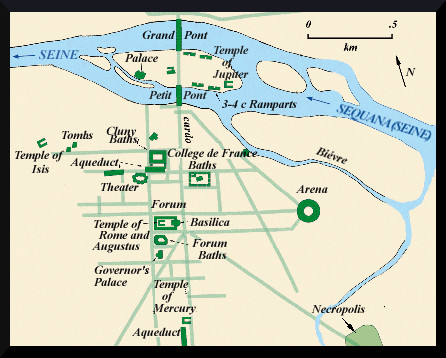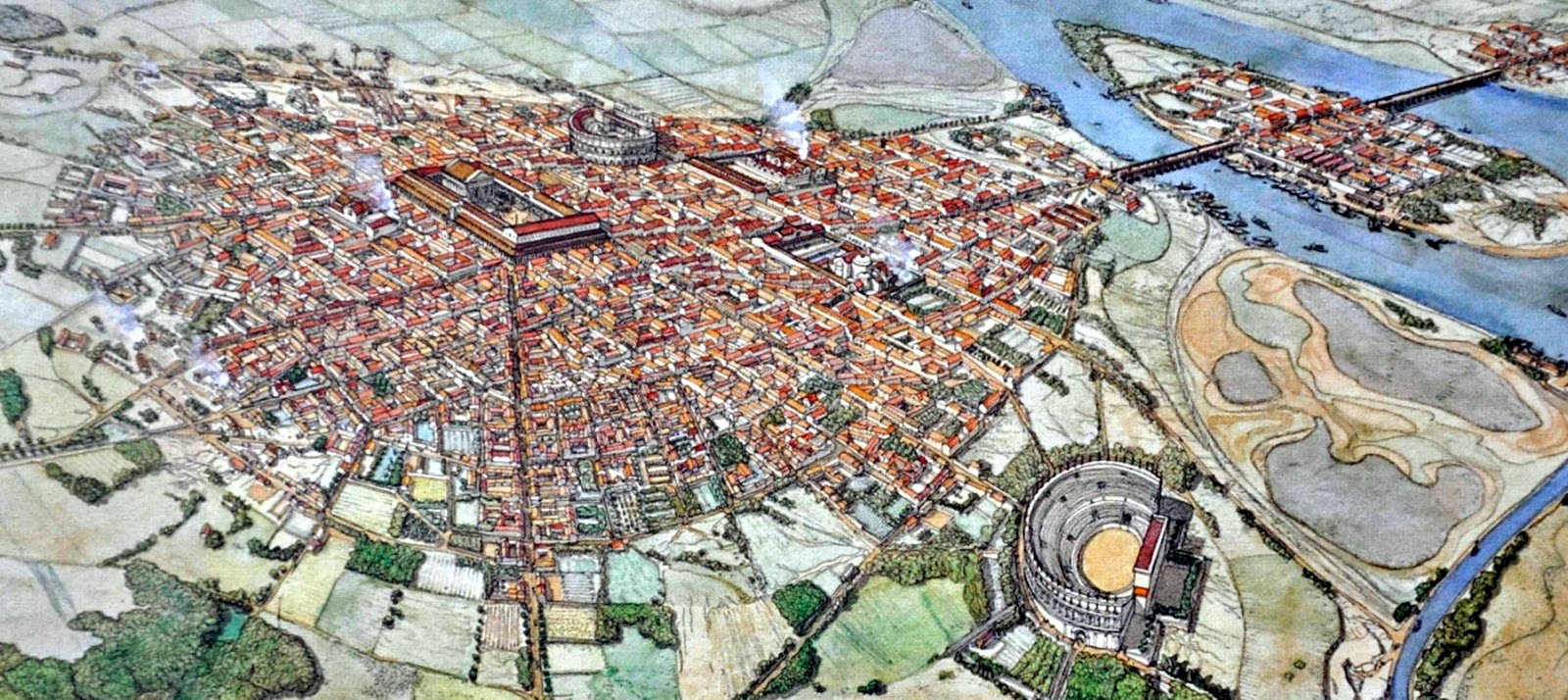Lutetia: Difference between revisions
No edit summary |
|||
| Line 1: | Line 1: | ||
;[[Paris]] -P- [[Paris - La Belle Époque]] | ;[[Paris]] -P- [[Paris - La Belle Époque]] -P- [[Arènes de Lutèce]] -P- [[Musée national du Moyen Âge]] -P- [[Pantheon, Paris]] | ||
[[File:Lutetia Reconstruction.jpg]] | [[File:Lutetia Reconstruction.jpg]] | ||
<br> | <br> | ||
Revision as of 10:51, 16 April 2017
- Paris -P- Paris - La Belle Époque -P- Arènes de Lutèce -P- Musée national du Moyen Âge -P- Pantheon, Paris
Roman Paris
 [Fig.1: Section of a map of Roman Paris (after Crypte Archéologique 2005, Paris; MacKendrick 1972)].
[Fig.1: Section of a map of Roman Paris (after Crypte Archéologique 2005, Paris; MacKendrick 1972)].
Paris occupies a natural limestone basin hollowed out by the Seine, which passes through the city en route to the Normandy coast about 150 km to the northwest. The conventional names of the Right and Left Banks of the Seine, used since ancient times, are oriented to face downstream (northwest). The surrounding heights of the Paris basin define the limits of the modern city, which extends 10 km in all directions from the center at the Île de la Cité. The ancient and medieval city was much smaller, measuring only about 2 km from end to end (fig.1).
While today the river level is some 9 m below street level, the ground surface was significantly lower in antiquity and the early Middle Ages, as attested to by the underground archaeological crypt found below Notre-Dame Cathedral (see Gallo-Roman remains beneath Notre-Dame cathedral). Much of the low-lying area east of the city was a swampy zone known as the Marais (built over in the 13th century, and today an upscale region of Paris), which was criss-crossed by small Seine tributary streams. During Roman times the city was called Lutetia, derived from an ancient Parisii word for marsh or swamp.
Ancient settlement in Paris
Late Iron Age towns were abundant along the Seine from the 3rd to 1st century BC, when the ancient Parisii (one of dozens of Celtic tribes in Gaul) inhabited the area around the Île de la Cité. At the time of the arrival of the Romans in 53-52 BC, the largest settlement of the Parisii seems to have been at Nanterre (15 km west of the Île de la Cité), where remains of a nucleated town have recently been discovered within a loop of the Seine, including several main streets and traces of hundreds of houses (see AR 4,1). Like many other prosperous Celtic groups from Late Iron Age Gaul, Britain, and Germany, the Parisii minted their own coins of bronze, silver, and gold, indicating their involvement in trade networks fed by Roman commerce in wine and other commodities.
Julius Caesar's account of the Gallic Wars, de Bello Gallico (ca. 50 BC), the earliest written source on the region, first mentions Lutetia as the scene where, in 53 BC, an annual assembly was held between Caesar, commander of the Roman Legions, and local Gallic leaders. In 52 BC, the Parisii broke their agreement with the Romans in order to support the Gallic war leader Vercingetorix. Their stronghold at Lutetia, left to be defended by the elderly warleader Camulogenus, was captured and burned by Labienus, one of Caesar's generals.
The Romans soon established a new town called Lutetia on the hills of the Left Bank of the Seine, with the forum located about 1 km south of the river (fig.1). Roman Lutetia was laid out at the intersection of the Seine and two parallel Roman roads running north-south. The right hand or easternmost of these (today's rue St-Jacques) served as the Roman cardo or main NS street. Ultimately coming from Spain, this road passed through Orléans (Cenabum) to Paris, crossed the Seine at the Île de la Cité via the Petit Pont ("small bridge") and Grand Pont ("large bridge," now the Pont Notre-Dame) and went north through Senlis. The second road (the present-day rue Galande), coming from Italy, passed through Lyon to Paris, then turned NW toward Beauvais, Rouen, and the Normandy coast. Linked by a grid of east-west streets, this network of Roman roads remained at the core of Paris through the Middle Ages (Didier Busson, 2003).
The Romanization of Paris was seemingly well underway by the early 1st century AD. Evidence for this comes from le Pilier des Nautes, an altar to Jupiter found under the choir of Notre-Dame cathedral. Erected by a corporation of local river merchants and sailors (nautes), it invokes several Roman deities along with native Gallic gods. Other temples and shrines from the Gallo-Roman period include a temple of Mercury on top of Montmartre, about 2 km north of the Seine. Mercury was a popular god in Gaul, often joined or syncretized with Gallic deities. A temple to the Egyptian goddess Isis, worshiped by many Romans including the Emperor Hadrian (AD 116-133), also lay in the Left Bank suburb of Locutitius, at the future site of St-Germain-des Prés.
The Roman forum measured 160 by 100 m, with a layout similar to those found in many Roman towns at the time of Trajan (AD 98-117). The interior open space of the forum was surrounded by shops in a rectangular portico, with a basilica (law court) at the east end, and a temple on the west end, thought to be dedicated to the official imperial gods Romae and Augustus. A permanent army or legionary camp existed nearby. Here, in AD 360, the troops proclaimed Julian II (fig.3) as their emperor. Soon thereafter, the Emperor Valentinian I (AD 370-375) is also recorded as staying in the camp (MacKendrick 1972).
By far the most conspicuous Roman ruins in Paris are the baths (thermae) of Cluny (fig.2), named after the 16th century Hôtel de Cluny built around them. Rediscovered in the 12th century, the Cluny Baths retain large sections of the frigidarium or cold rooms showing massive walls and vaulted openings, which provided a direct model for medieval architects building cathedrals, bridges, and other large structures in the Romanesque style. The Cluny baths were fed by a subterranean aqueduct with a source 16 km to the south at Rungus, with an estimated capacity of 2,000 m3 per day (MacKendrick 1972). In 1903-04, a second and third set of Roman baths came to light in Paris, one lying just south of the forum and another found in the College de France, possibly part of a palace or luxurious private home.
The Roman town of Lutetia also had an open-air amphitheater on the Left Bank that could hold 8,000-9,000 spectators, as well as a smaller covered theater for an audience of up to 4,500, and a chariot racing circuit or circus. Town administration buildings were located on the Île de la Cité as well as in the forum. By the late 3rd century, when Germanic invasions forced defensive reorganization of Lutetia, a praesidium or headquarters was in the northern end of the Île, to be used by Julian II in AD 357-360. This underlay the medieval Royal Palace, and now holds the Palais de Justice.
A Roman necropolis existed at the southern periphery of Lutetia along the main Roman north-south road coming from Orléans, and Roman and Merovingian tombs lay along roads leading out of the city. Another necropolis with Gallo-Roman and Merovingian tombs was near the Petit Pont around the Churches of St-Julien-le-Pauvre and St. Séverin. Both churches were built on tombs of Roman-era martyrs, part of a continuity between Late Roman and early medieval religion and burial customs.
Julian II and The Salian Franks
Germanic invasions by the Franks and Alemanni in the late 3rd century AD destroyed much of the Left Bank portions of the Gallo-Roman city of Lutetia, forcing its contraction into a defensive stronghold on the Île de la Cité, utilizing the Seine for protection. Walls were built along the island perimeter from large stones taken from damaged Left Bank structures.
In AD 357-8, Julian II (fig.3), then serving as consul and general commanding Gallic Legions, moved the Roman capital of Gaul from Trier to Paris, which he defended against Germanic invaders coming from the north, down the road from Senlis. Prior to being proclaimed emperor by his troops in 360, Julian II (also known as Julian the Apostate since he rejected Christianity as the official Roman religion) defeated the Franks in a major battle at Strasbourg in AD 357. Julian then fatefully allowed the Salian Franks to settle the west bank of the Rhine, in exchange for their military services. Between AD 380 and 400 the Franks provided an effective barrier against the invading Visigoths (pushed across the Danube by the expansion of the Huns), and again in AD 406, against the Vandals, Suebi, and Alani who crossed the Rhine, but were diverted southward through Aquitaine and into Spain.
In AD 451 the Huns, a huge army of Asiatic nomads, invaded Gaul under their warleader Attila in search of additional subjects for the extortion of tribute money, a livelihood they had perfected in the Danube region during the previous half century. Just as they seemed about to sack Paris, the Huns altered their course to the south, only to be defeated near Orléans by Aetius, the last effective general of the Roman Imperial armies. A young Christian girl named Geneviève, who had preached to the alarmed Parisians that God would intervene on the city's behalf, later became the patron saint of Paris.
Due to ongoing rivalries between Byzantine and Roman leadership, Aetius was assassinated in AD 453 by the eastern Emperor Valentinian III. Thus Roman control of northern France effectively ended, although the local general Siagrius nominally upheld Roman rule from Soissons in the Picardie region of northern France, even after the defection of the last Roman emperor, Romulus Augustulus, in 476. In AD 486 Siagrius was finally defeated in battle by Clovis, King of the Salian Franks. Using the political vacuum in Gaul to his advantage, Clovis took over the remnants of the Roman army and administrative structure, thus commencing the Frankish or Merovingian period in France.
Source
The above text appears on pages 22-26 of Ancient and Medieval Paris: A Background to the Gothic era of Vol.4 No.2 of Athena Review.
References
Busson, Didier. 2003. Paris, a Roman city. (tr. A. Keens). Paris, Éditions du Patrimoine.
Caesar, J. 50 BC. The Conquests of Gaul (tr. S.A. Handford, 1951, revised in 192 by J.F. Gardner). New York, Viking Penguin Inc.
Cole, R. 2003. A Traveller's History of Paris. 3rd edition. Northhampton, MA, Interlink Books.
Gregory of Tours (orig. 6c AD). History of the Franks. (tr. E. Brehaut Ph.D, 1916). New York, Columbia University Press.
Mackendrick, P. 1972. Roman France. New York, St. Martin's Press.
Websites
http://www.athenapub.com/14roman-paris.htm (Above text taken from this page.)
http://www.iub.edu/~paris10/ParisOSS/Day_2_Early_Paris/Ancient_Early_Medieval/McGregor_Lutetia.html
http://www.medicographia.com/2012/11/lutetia-the-gallo-roman-ancestor-of-paris/ (A detailed scholarly work and worth the time to read.)
https://en.wikipedia.org/wiki/Lutetia (A good starting place, but being a Wiki it is frighteningly short and inaccurate, still...)
